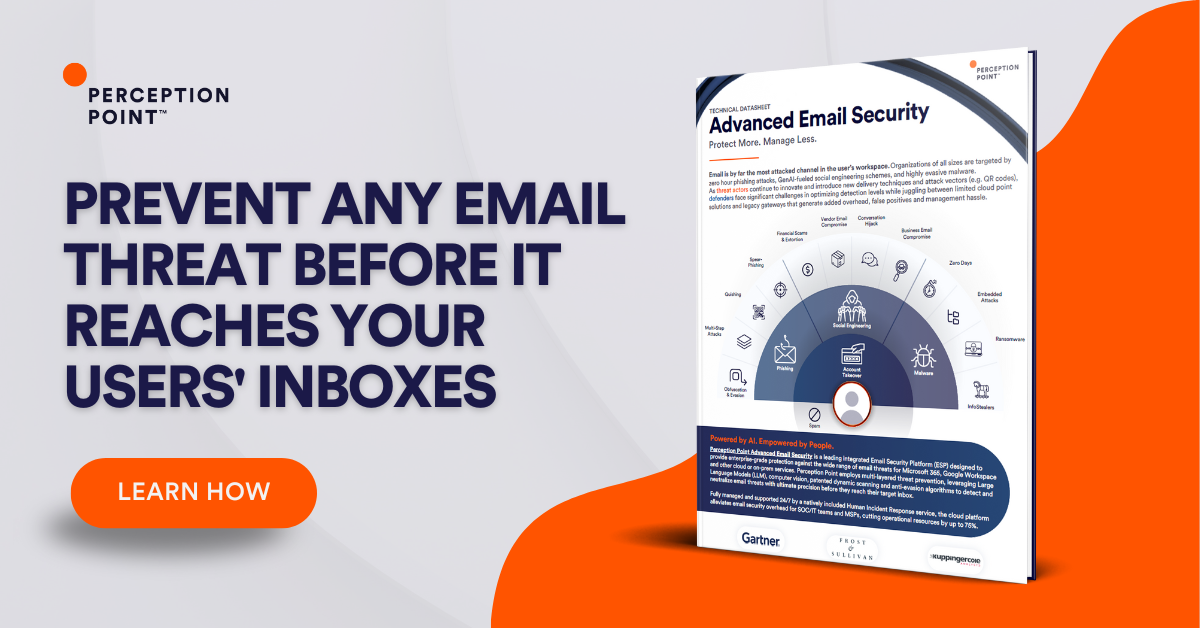What Is an Email Security Policy?
An email security policy is a set of guidelines designed to protect an organization’s email communications. It addresses potential threats such as phishing, malware, and data breaches by establishing rules and behaviors for handling email. The policy aims to protect sensitive information, ensuring it remains confidential and secure within the organization.
This policy forms part of an organization’s wider cybersecurity strategy. By explicitly outlining acceptable use and security practices, it helps prevent unauthorized access and misuse of email systems. The policy also guides employees on how to recognize and handle suspicious emails, reducing the risk of security incidents.
In this article
Why Your Organization Should Have an Email Security Policy
Here are a few reasons you should strongly consider creating an email security policy for your organization:
- Mitigates risk of email threats: An email security policy significantly reduces the risk of falling victim to cyber threats such as phishing, malware, and ransomware, which often enter through email systems.
- Protects sensitive information: By setting guidelines on how to handle and secure email communications, it ensures that sensitive data remains confidential and is not exposed to unauthorized entities.
- Compliance with regulations: Many industries have regulations requiring the protection of sensitive information. An email security policy helps ensure compliance with these legal and regulatory requirements.
- Educates employees: The policy serves as a foundation for employee education on the importance of email security, outlining their roles and responsibilities in protecting the organization’s digital assets.
- Improves email management: An email security policy encourages good email management practices, helping to maintain an efficient and secure email system.
- Promotes a culture of security: Email security policies reinforce a security-conscious culture within the organization, where all employees are aware of the risks and contribute to the security of information systems.

Tal ZamirCTO, Perception Point
Tal Zamir is a 20-year software industry leader with a track record of solving urgent business challenges by reimagining how technology works.
TIPS FROM THE EXPERTS
- Integrate DKIM, SPF, and DMARC into your email security framework. Ensure your policy mandates the use of DKIM (DomainKeys Identified Mail), SPF (Sender Policy Framework), and DMARC (Domain-based Message Authentication, Reporting & Conformance). These protocols significantly reduce the risk of email spoofing by verifying sender authenticity and should be actively enforced.
- Leverage AI-driven anomaly detection. Incorporate advanced AI systems that can identify unusual patterns in email traffic, such as deviations in communication behavior or the use of new and unfamiliar domains. These systems can act as an early warning mechanism for potential phishing attempts or internal compromises.
- Establish a “zero-trust” approach to email access. Adopt a zero-trust model where no user or device is trusted by default, even if they are within the network perimeter. This includes enforcing strict access controls, continuous verification of user identities, and segmenting access to email systems to minimize risk.
- Conduct periodic phishing simulation exercises. Regularly test your employees with simulated phishing attacks to evaluate their vigilance and response to suspicious emails. Use the results to tailor ongoing training and adjust the policy to address identified weaknesses.
How Does an Email Security Policy Work?
An email security policy works by clearly defining what is considered secure and acceptable use of the organization’s email system. It establishes guidelines on how emails should be managed, including the sending, receiving, and storing of electronic messages. The policy outlines preventive measures against threats and instructions for identifying and reporting potential security breaches.
It functions as a living document, evolving as new risks are identified and technology advances. The policy’s effectiveness relies on regular updates and employee training. By ensuring everyone understands their role in email security, the policy creates a culture of security awareness that reinforces the organization’s digital defenses.
9 Key Elements of an Email Security Policy
A comprehensive email security policy should include the following elements.
1. Purpose
This section of an email security policy explains why the policy exists. It highlights its importance in protecting the organization’s information assets. This part also clarifies what risks the policy aims to mitigate, ensuring employees understand its significance.
2. Ownership
The ownership section specifies who is responsible for the email security policy. This includes maintaining, reviewing, and updating the policy. The policy is often owned by the IT or cybersecurity department, but there is an important role for management in endorsing and enforcing the policy. By defining ownership, the policy establishes clear lines of accountability.
3. Privacy
The privacy section outlines how the organization will protect the confidentiality of email content. It details measures to prevent unauthorized access and disclosure of sensitive information. This includes encryption, secure password practices, and guidelines on sharing information via email. It also addresses expectations of privacy from an employee perspective, clarifying any monitoring practices.
4. Usage
Usage guidelines define acceptable and prohibited uses of the company email system. This includes restrictions on sending confidential information, opening attachments from unknown sources, and forwarding chain emails. The section aims to prevent behaviors that could compromise security.
It also covers the use of email for personal purposes, setting boundaries to ensure that work email accounts are primarily for professional communications. This helps maintain professional standards and security integrity.
5. Responsibilities
The responsibilities section details what is expected from each employee regarding email security. It includes adhering to the policy guidelines, reporting suspected security incidents, and participating in training. Management responsibilities include ensuring the policy is communicated and enforced, while IT departments are tasked with providing secure email infrastructure and responding to incidents.
6. Restrictions
Restrictions highlight specific activities and actions that are strictly prohibited in the use of company email. This can include the transmission of confidential data without proper encryption, use of unauthorized email clients, and opening suspicious attachments. By setting clear boundaries, the policy seeks to minimize exposure to cyber threats.
7. Consequences
The consequences section outlines the potential disciplinary actions for policy violations. This can range from verbal warnings to termination of employment, depending on the severity of the breach. The purpose is to enforce policy compliance and demonstrate the organization’s seriousness about email security. It also serves as a deterrent against negligent behavior.
8. Reporting
The reporting section provides procedures for notifying the appropriate parties about suspected security issues or policy violations. It specifies who should be contacted, how, and when. This ensures timely and effective responses to potential threats. Encouraging prompt reporting, the policy fosters an environment where security concerns can be openly discussed and addressed.
9. Administrative Information
Administrative information covers policy governance details, such as revision history, version control, and document ownership. It provides a record of updates and changes, ensuring the policy remains current and relevant. This section also details the frequency of reviews and the process for making amendments.
Related content: Read our guide to email security issues
How to Build a Successful Email Security Policy
Here are best practices for creating a winning email security policy.
Start from a Policy Template
Using an existing security policy template can accelerate the development of an email security policy. Templates provide a structured framework that covers key aspects of email security. They save time and ensure that critical elements are not overlooked.
Templates serve as a guide, but customization is essential to address the organization’s specific context. This includes adding company-specific practices, adjusting guidelines to align with the business environment, and incorporating legal and regulatory obligations.
Align Email Security Technologies and Configurations with the Policy
Security tools and configurations play a critical role in enforcing the email security policy. This includes spam filters, encryption, and access controls. Ensuring these technologies align with the policy standards enhances protection against threats. Regular reviews and updates of security configurations are necessary to keep pace with evolving risks.
Devise a User Policy Agreement and Acknowledgment Plan
A plan for user agreement and acknowledgment ensures all employees formally recognize and commit to the email security policy. This could involve signing a document or completing an online acknowledgment form. It serves as both a formal agreement and a reminder of individual responsibilities. Regular updates and re-acknowledgment keep the policy in the forefront of employees’ minds.
Develop Incident Response Procedures
Incident response procedures are vital for effectively managing and mitigating the impact of a security breach or suspicious activity within the email system. These procedures should outline step-by-step actions to be taken in the event of an incident, including initial detection, containment strategies, eradication of threats, and recovery processes.
It’s important to designate specific roles and responsibilities to team members, ensuring a coordinated response. Regular drills and simulations can help prepare the team for actual incidents, improving reaction times and decision-making under pressure.
Invest in Employee Training
Employee training is a cornerstone of a robust email security policy. Regular, comprehensive training sessions should educate employees on the latest cybersecurity threats, such as phishing scams and malware, and how to avoid them. Training should also cover the organization’s specific email usage policies and procedures for reporting suspicious emails.
Advanced Email Security with Perception Point
While there is no replacement for email security practices in your organization, a dedicated email security solution can provide stronger email safety. For example, Perception Point’s AI-powered Advanced Email Security contains multiple scanning engines and threat intelligence for enhanced protection against attacks like phishing, spam, malware and BEC.
For advanced threats, the solution leverages hardware-based and software-based tracking to identify evasive threats. Proprietary software algorithms scan code at the CPU-level to intercept attacks at the earliest stage possible – the exploit – before malware is even delivered.
Perception Point is easy to deploy, analyzes email in seconds, and can scan email traffic at any scale, leveraging the flexibility of the cloud.
Learn more about Perception Point Advanced Email Security

An email security policy is a set of guidelines designed to protect an organization’s email communications. It addresses potential threats such as phishing, malware, and data breaches by establishing rules and behaviors for handling email.
Here are a few reasons you should strongly consider creating an email security policy for your organization:
– Mitigates risk of email threats
– Protects sensitive information
– Compliance with regulations
– Educates employees
– Improves email management
– Promotes a culture of security
An email security policy works by clearly defining what is considered secure and acceptable use of the organization’s email system. It establishes guidelines on how emails should be managed, including the sending, receiving, and storing of electronic messages.
A comprehensive email security policy should include the following elements.
1. Purpose
2. Ownership
3. Privacy
4. Usage
5. Responsibilities
6. Restrictions
7. Consequences
8. Reporting
9. Administrative Information
Here are best practices for creating a winning email security policy.
1. Start from a Policy Template
2. Align Email Security Technologies and Configurations with the Policy
3. Devise a User Policy Agreement and Acknowledgment Plan
4. Develop Incident Response Procedures
5. Invest in Employee Training
























